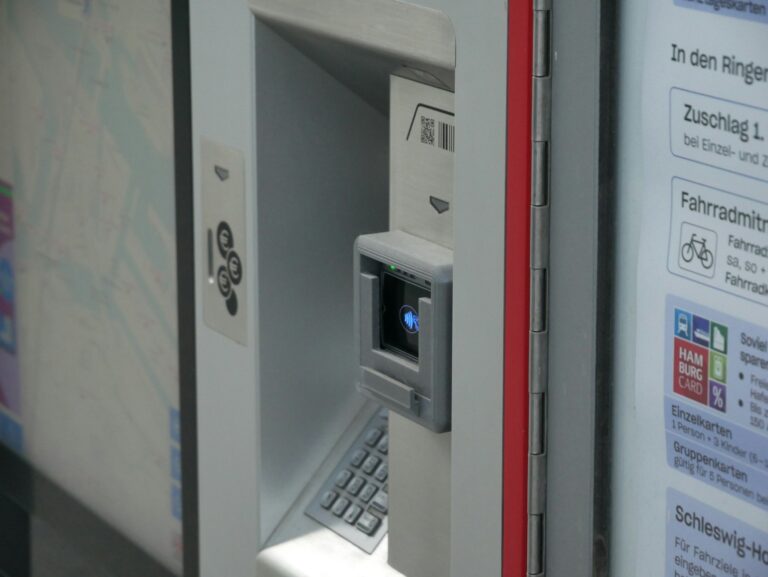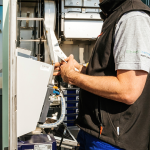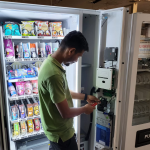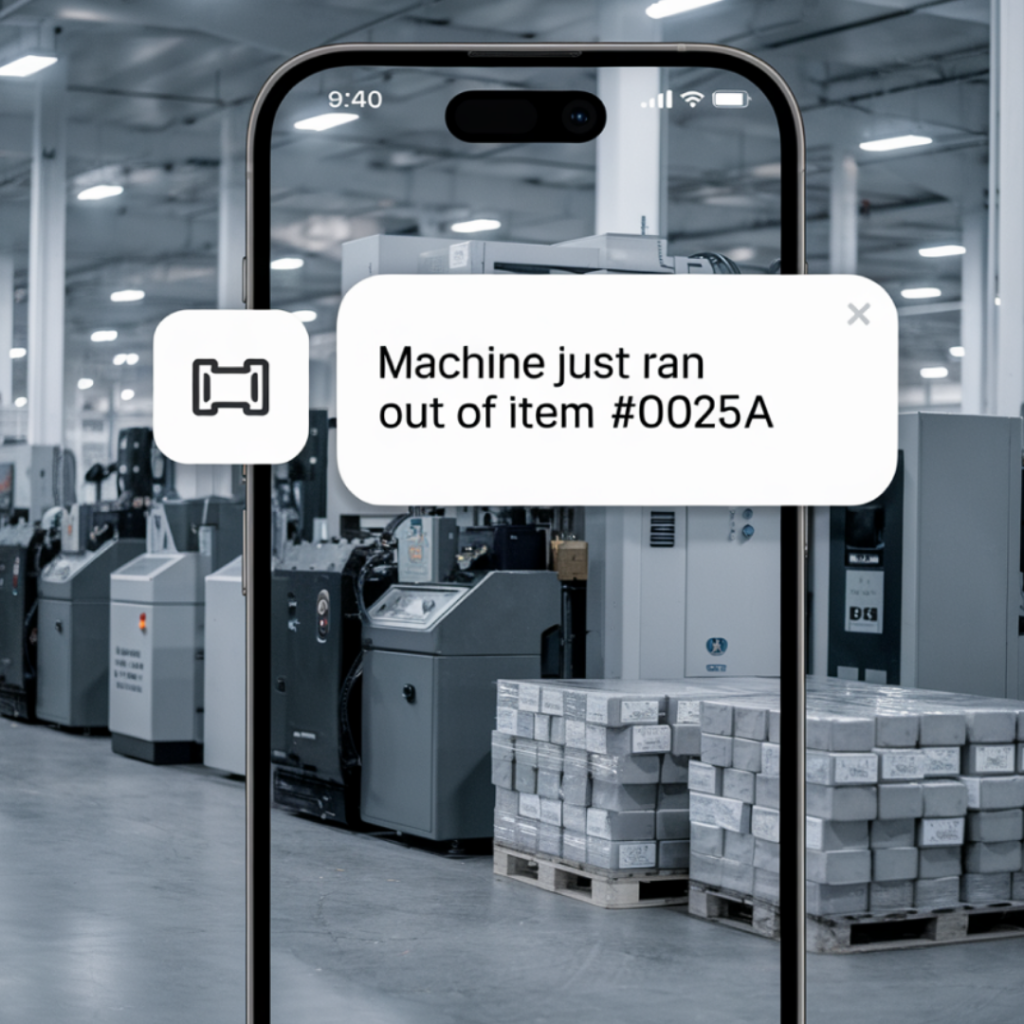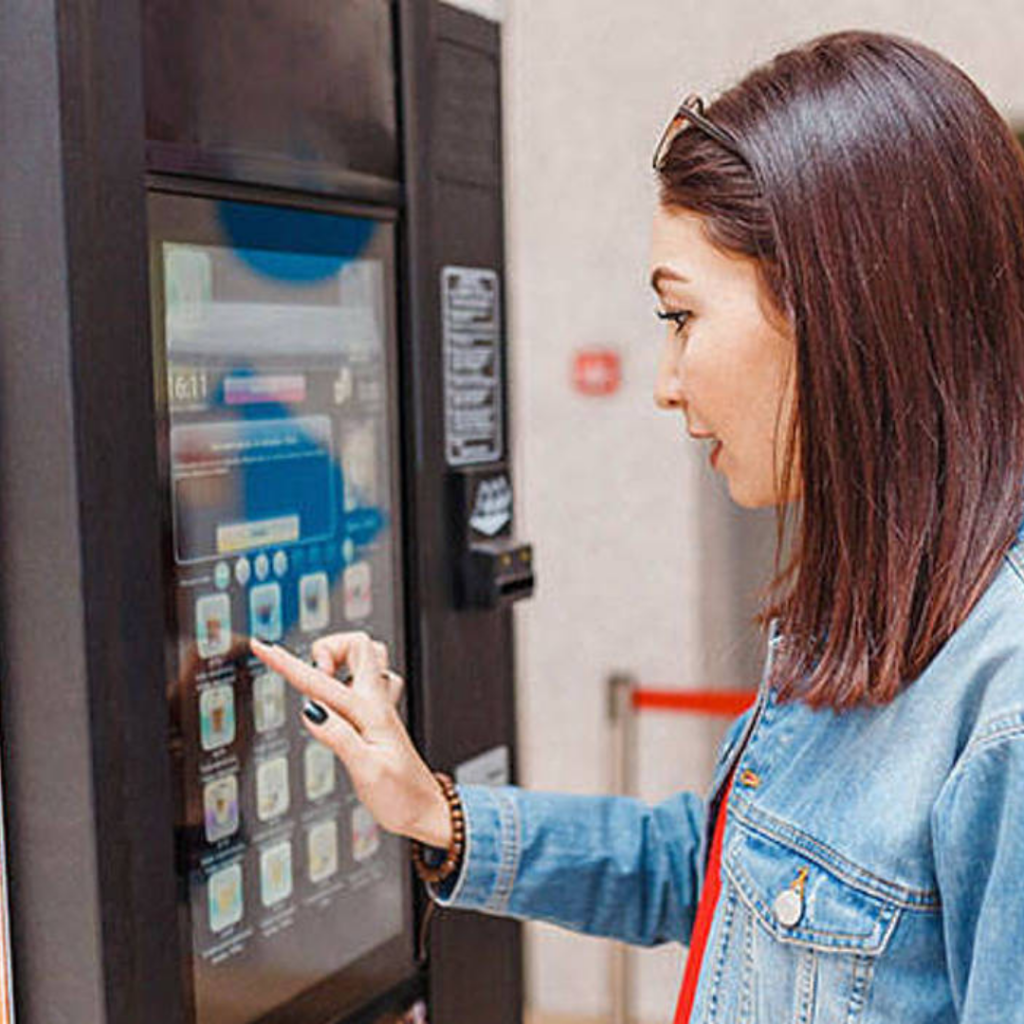Export ready American built machines in stock, shipping from Miami
How to Start a Vape Vending Machine Business
Start A Vape Vending Machine Business Legally And Profitably. Learn Licensing, Setup Steps, Costs, And Smart Strategies For Success.

The vape vending machine business is changing how adults buy vapor products. These machines use secure, cashless, and age-verified systems to sell vapes and accessories automatically. As the vape market grows, more entrepreneurs want to start a vape vending business that is simple, compliant, and profitable.
Unlike snack or drink vending, vape vending machines work entirely without cash. Buyers scan a government ID, confirm their age through software, and pay by card or mobile wallet. The sale only completes when both ID and payment pass verification. This process keeps every transaction safe and legal.
Because these machines are small and automated, they need little space and almost no labor. They can run 24 hours a day in adult-only places such as bars, clubs, casinos, or lounges. As a result, operators enjoy low overhead with steady vape vending profitability.
This type of business suits many people. Bar owners can add passive income. Side-hustlers can test the model with one or two units. Full-time route operators can expand quickly by adding more machines. With good planning, legal compliance, and smart location choices, the vape vending machine business can become a strong and reliable source of income.
Know the Legal Rules Before You Start
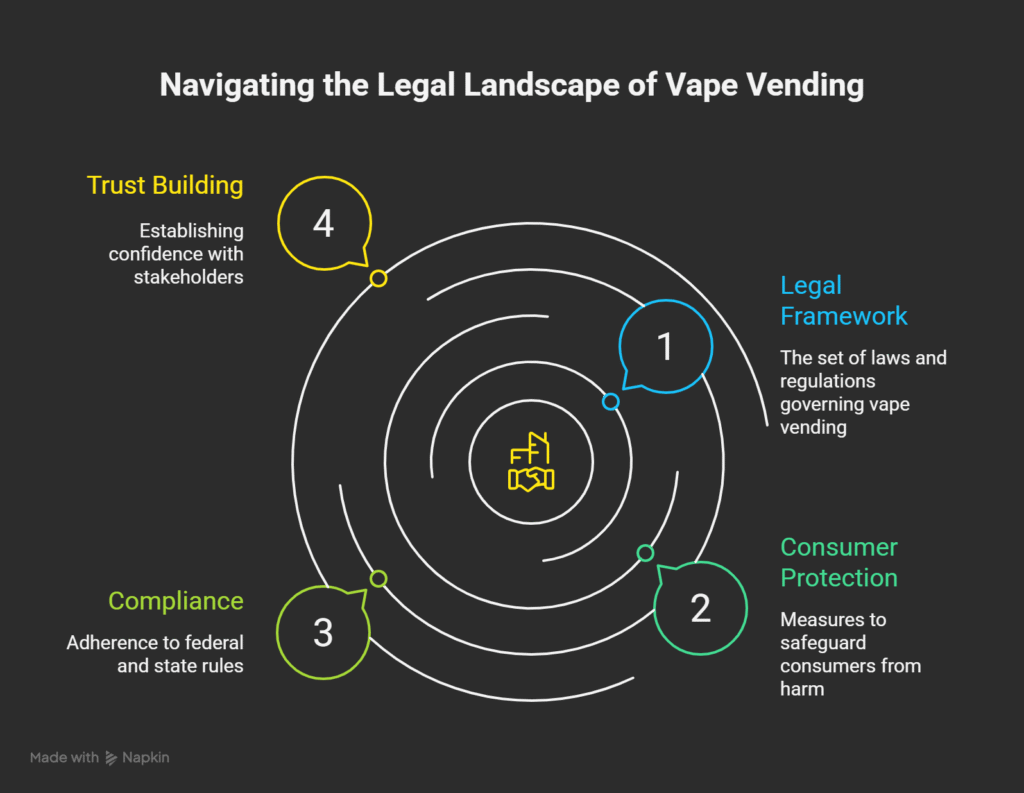
Before starting any vape vending machine business, understanding the legal framework is essential. Every operator must follow vape vending laws that protect consumers and ensure compliance with federal and state rules. Getting this step right builds trust with both venue owners and regulators.
Under the federal Tobacco 21 law, all vape product buyers must be 21 years or older. Because of this rule, vending machines can only operate in adult-only locations. These include bars, nightclubs, casinos, or private lounges where minors are never allowed. If a venue mixes ages, vending is not permitted.
Federal law also requires strict age verification vending technology. Machines must confirm a customer’s age before any sale takes place. Most systems do this automatically by scanning a government-issued ID and matching the data with verification software. In some areas, a human attendant must be nearby to confirm each sale. Either method is acceptable if it prevents underage access.
“Adult-only” means a controlled environment where everyone inside is 21 or older. Examples include private cigar rooms, hookah lounges, and certain high-end entertainment venues. Keeping machines in these restricted spaces helps maintain full vape vending compliance and protects your business license.
Compliance should always come first. It is the foundation of a credible operation. When you follow the laws, you reduce risk and show venue partners that your route is professionally managed. Starting your business the right way makes future growth much easier.
Laws, Permits & Which States Allow Vape Vending Machines
Understanding vape vending permits and local laws is the most important part of building a compliant route. Although federal rules set a national baseline, each state can add its own restrictions. Some allow vending in adult-only locations, while others ban it entirely. Before installing your first unit, research where your business can legally operate.
Federal Baseline Rules
At the federal level, the Tobacco 21 law applies nationwide. It sets the minimum age for vape purchases at 21. Vending machines can only be placed in venues that restrict access to adults. This means no minors can enter the location at any time. The FDA also requires ID verification for every transaction to prevent underage sales.
- Buyers must be 21 or older to purchase any vape product.
- Machines must be in adult-only locations (bars, clubs, lounges).
- Operators must use approved age-verification technology or a supervised process.
Typical Business Permits You’ll Need
In most states, operators must hold several permits to stay compliant with vape vending laws. These documents verify that your business collects tax correctly and sells products legally.
- Retail License: Required to sell electronic nicotine delivery systems (ENDS) or vape products.
- Sales Tax Certificate: Allows you to collect and remit sales tax properly.
- Tobacco/Vape Distributor Permit: Needed if you buy wholesale inventory from suppliers.
- Local Zoning or Placement Approval: Confirms your machine meets local vending and location standards.
State Vape Vending Laws and Status
Here is a current overview of where vape vending machines are legal. Because laws change often, confirm every six to twelve months with your state’s Department of Health or revenue office.
| State | Vape Vending Status | Notes |
|---|---|---|
| California | ❌ Prohibited (adult-only lounges only) | Strong flavor bans and local restrictions apply |
| Texas | ✅ Allowed in adult-only venues | Must use electronic ID verification |
| Florida | ✅ Allowed with tobacco retail permit | Active compliance inspections by state agencies |
| New York | ❌ Prohibited | Statewide flavor ban and vending restriction |
| Ohio | ✅ Allowed in adult-only venues | Requires retailer license and local compliance |
| Nevada | ✅ Allowed | City or county vending permits may be required |
| Pennsylvania | ✅ Adult-only venues only | Retailer permit and signage rules apply |
Quick Compliance Tip
Many states do not ban vending outright. Instead, they limit access to adult-only areas and require licensing. Keep a digital folder with copies of all your vape vending permits and renew them before expiration. Staying organized helps prove your commitment to vape vending compliance if an inspector ever asks for proof.
Finally, check both state and city ordinances before every new installation. Local rules can differ even within the same state. A short call to the local licensing office can save time and prevent costly mistakes.
Choosing the Right Vape Vending Machine
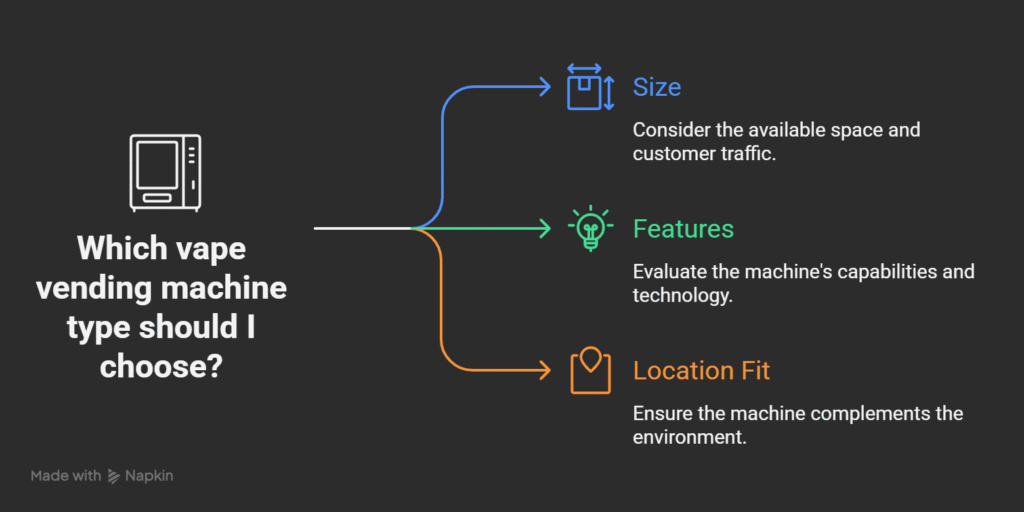
Selecting the right equipment is one of the most important choices in your vape vending machine business. The machine you choose affects reliability, compliance, and customer experience. With several vape vending machine types available, it’s best to compare size, features, and location fit before you buy.
Popular Vape Vending Machine Types
Each machine design serves a different business goal. Below is a comparison table to help you choose wisely.
| Machine Type | Description | Best For |
|---|---|---|
| Wall-Mounted Vape Vending Machine | Compact and space-saving. Mounts securely on walls and can hold 30–60 SKUs. Includes card reader and optional ID scanner. | Bars, small lounges, or music venues with limited floor space. |
| Slim Vape Vending Machine | Narrow, free-standing unit designed for tight areas. Usually supports cashless payments and built-in security camera. | Hotel corridors, casino entrances, or small smoking zones. |
| Screenmount Vape Vending Machine | Features a digital touchscreen for easy browsing. Can promote brands, display prices, and verify age using an ID scan. | Modern bars, airports, and luxury lounges where user experience matters. |
| Tall Floor-Standing Machine | Full-size unit with up to 300 SKU capacity. Often supports cloud monitoring and video ads. | Casinos, high-traffic clubs, or vending routes with heavy demand. |
Key Features to Look For
When comparing machines, prioritize technology and reliability. A smart vending machine with ID scanning is not just modern—it protects your license and your brand. Look for these must-have features:
- Built-in Age Verification: Camera and ID scanner to confirm buyers are 21 or older.
- Cashless Payments: Support for tap, chip, and mobile pay options.
- Cloud Monitoring: Remote access to stock levels, sales data, and alerts.
- Durable Steel Build: Tamper-proof body with internal camera for security.
- Custom Branding: Optional LED lighting and video screens to display product images or promotions.
Smart Buying Tip
Always ask the manufacturer if the unit supports age-verification vending. A certified ID scanner ensures your machine meets federal and state compliance requirements. Also, check if the supplier offers technical support or replacement parts. Investing in the right vape vending machine type today saves you time and costs as your route grows.
With your machine selected, the next step is stocking it correctly. Knowing how to source compliant and profitable vape products will help you maintain steady sales and high margins.
Sourcing Vape Products and Accessories
Once your machines are ready, it’s time to choose what to sell. Building the right vape vending inventory is about balance—popular items must meet legal standards and fit your vending machine’s storage limits. A strong product mix keeps customers returning while maintaining compliance with local laws.
Buy Only from Licensed Distributors
Always work with verified wholesalers or licensed distributors. These partners provide proper invoices, product authenticity, and compliance documents. Avoid buying from gray-market suppliers or unverified online sellers. Licensed distributors ensure your sourcing vape products process stays within federal and state rules, which protects your vending business from costly violations.
Follow Flavor and Nicotine Rules
Each state controls which vape flavors and nicotine strengths are legal to sell. Many states restrict fruit or sweet flavors, allowing only tobacco or menthol. Before you stock any product, review your local flavor regulations and nicotine limits. Staying compliant helps you avoid fines and protects your vape vending machine business reputation.
Start Small, Then Expand
When you first start a vape vending business, limit your inventory to the best-selling products. This approach reduces waste and keeps cash flow steady. Once you see which brands move fastest, you can expand your range to include premium or niche options.
| Category | Recommended Products | Notes |
|---|---|---|
| Disposable Vapes | Popular brands like Elf Bar, Lost Mary, or Fume | High turnover and wide flavor variety |
| Pod Systems | JUUL, Vaporesso, or SMOK replacement pods | Ideal for refill users who prefer compact systems |
| Chargers & Accessories | USB-C vape chargers, refill bottles, or silicone cases | Low-cost items that increase basket value |
Maintain a Balanced Product Mix
Successful operators mix top-selling items with a few unique options. For example, stock 80 percent proven brands and 20 percent trial products. This keeps your vape vending inventory fresh and attracts repeat customers who like variety. Track which SKUs sell fastest using your cloud dashboard and reorder based on data, not guesswork.
Check Product Packaging and Labels
Before loading your machine, confirm each item includes required health warnings and nicotine content labels. The FDA enforces these packaging rules strictly. Proper labeling also builds trust with customers, who expect clear information about what they are buying.
By carefully sourcing vape products from licensed suppliers and following label standards, you keep your business compliant and professional. Next, it’s time to choose where to place your machines so your products reach the right audience.
Finding the Best Locations for Your Machines
Why Location Matters in Vape Vending
Choosing the right site is one of the most important decisions in a vape vending machine business. The best locations combine consistent foot traffic, adult-only access, and enough space for your unit. A great spot can double your monthly sales, while a poor one may lead to low turnover. Understanding how to evaluate and negotiate placements will determine your long-term success.
Top Venues for Vape Vending Machines
The best locations for vape vending are adult-only environments where buyers already expect to see vape products. Bars, nightclubs, casinos, and music venues offer ideal exposure because visitors stay for long periods and are often looking for a quick, convenient purchase. These locations also reduce compliance risk since no minors can enter. Some private lounges and hookah bars even request machines directly, especially in areas where vape retail shops close early.
How to Evaluate Vape Vending Placement
When visiting potential venues, observe their layout and customer flow. Look for open wall space or unused corners with power access and visibility. The perfect vape vending placement is near entrances, smoking patios, or bar counters—areas with high movement but limited retail competition. Avoid hidden or poorly lit sections where customers might overlook the machine. If the space already has an ATM or snack vendor, ask how those machines perform. It gives you an idea of average foot traffic and transaction potential.
Venue Performance Comparison
Below is a quick comparison of venue types and their expected results. These figures are averages from operators who track sales through cloud systems, though performance can vary by region.
| Venue Type | Foot Traffic | Sales Potential | Placement Tip |
|---|---|---|---|
| Bars and Pubs | Medium to High | $800–$1,200 per month | Mount on wall near bar counter or smoking area |
| Nightclubs | High | $1,200–$1,800 per month | Place near VIP lounge or coat check where visibility is constant |
| Casinos | Very High | $1,500–$2,000 per month | Install near smoking zone or entry gate for easy access |
| Music Venues | Seasonal | $700–$1,000 per month | Ideal near ticket booths or rest areas |
| Private Lounges or Hookah Bars | Moderate | $600–$900 per month | Wall-mount unit by reception or bar counter |
Negotiating and Tracking Location Performance
Negotiating placement terms is straightforward when you provide value. Many venue owners prefer a simple rental fee or a revenue share of 10 to 20 percent. For example, if your machine earns $1,000 in monthly sales, a 15 percent share gives the venue $150 and keeps the partnership fair. A transparent agreement builds trust and helps secure more locations later. Consider offering free signage or digital promotions on your screenmount vending machine to add value for the venue.
Once your first units are placed, visit them often to check traffic and sales. Data from your cloud dashboard will reveal which sites perform best. Over time, you’ll know exactly what kind of environment supports high returns. Smart location matching ensures your vape vending machines stay visible, profitable, and compliant with local laws.
Now that you know how to place your machines effectively, the next step is understanding costs and how profit margins actually work in this business.
Understanding Costs and Profit Potential
Before you invest, it is important to understand how the numbers work in a vape vending machine business. Knowing your costs and returns helps you plan better, set realistic goals, and manage your route like a true operator. With proper pricing and placement, vape vending profitability can match or even exceed traditional vending categories.
The main expenses include the machine itself, vape product inventory, payment systems, and location agreements. The biggest variable is sales volume, which depends on how well your machines are placed and maintained. Once you know your base costs, you can forecast realistic profit margins and cash flow.
Typical Startup and Operating Costs
Here is a breakdown of common startup and recurring expenses for one vape vending machine. Costs vary depending on the equipment model and state permit fees, but these averages provide a reliable baseline for new operators.
| Expense Type | Estimated Cost Range (USD) | Notes |
|---|---|---|
| Machine Purchase | $3,000 – $8,000 | Smart, wall-mounted, or screenmount models with ID verification |
| Initial Inventory | $800 – $1,200 | Includes disposables, pods, and accessories |
| Business Licenses and Permits | $300 – $1,000 | Vape retail, vending, and resale certificates |
| Insurance Coverage | $200 – $400 per year | General and product liability policies |
| Location Fee or Revenue Share | 10–20% of sales | Usually shared with venue owners monthly |
Calculating Vape Vending Profit Margin
The most profitable vending machines balance strong markup with consistent turnover. On average, operators buy disposable vapes for $7 to $9 and sell them for $20 to $25. That means each unit earns about $12 to $15 in gross margin before expenses. When placed in a busy adult venue, a single machine can easily move 2 to 3 items per day.
For example, if you sell 75 units per month at $15 profit each, that’s $1,125 gross margin. After subtracting card processing fees, sales tax, and a 15 percent venue share, the net profit is typically around $800 to $1,000 monthly per machine. Routes with multiple units in high-traffic spots can generate several thousand dollars per month with modest effort.
Understanding the Profit Curve
It usually takes two to three months for a new machine to reach stable sales levels. Early on, you may need to adjust pricing or restock more often to match customer preferences. However, once regular patterns form, your vape vending profit margin becomes predictable. Cloud reports make it easy to compare locations and decide where to add more units.
Here’s a simplified profit example for one fully operational vending machine:
| Category | Monthly Amount |
|---|---|
| Gross Sales | $1,800 |
| Product Cost | -$675 |
| Revenue Share (15%) | -$270 |
| Processing & Misc. Fees | -$75 |
| Estimated Net Profit | $780 per month |
These results depend heavily on traffic, pricing, and machine visibility. Still, many operators report similar figures once routes mature. The key to steady vape vending profitability is combining good locations, reliable equipment, and regular restocking. With your financial model in place, the next step is learning how to manage daily operations efficiently.
Running Daily Operations Smoothly
Why Consistent Operations Matter
Once your machines are placed and stocked, daily management becomes the key to keeping profits steady. A well-run vape vending machine business depends on routine checks, smart scheduling, and organized record-keeping. Consistency reduces downtime, prevents stockouts, and ensures every machine meets compliance standards. Even one missed refill can affect your customer trust and sales performance.
Scheduling Refills and Route Planning
Most operators service each machine once or twice a week, depending on traffic and product turnover. Bars and nightclubs may need more frequent restocks, while lounges and casinos often run longer between visits. Plan your route efficiently to minimize driving time. Many successful operators group machines by neighborhood or venue type, which makes restocking faster and more predictable. Use your vending management software to track inventory levels, sales reports, and alerts from all machines in one dashboard.
Using Cloud Software for Real-Time Tracking
Modern vape vending machines now include built-in cloud systems that let you monitor sales and stock remotely. Through this software, you can view real-time numbers, identify top-selling products, and even receive low-stock notifications. These tools save hours of manual checking and help prevent unnecessary site visits. Some systems also show transaction details, including payment types and time stamps, giving you full control of your operation from anywhere.
Vape Vending Maintenance Basics
Regular upkeep protects your investment and ensures a reliable customer experience. Cleaning the ID scanner, checking the card reader, and inspecting the internal camera once a week helps prevent technical issues. Always test payment systems after every refill to confirm that all methods—tap, chip, and mobile—work correctly. Wipe screens and outer panels with a non-abrasive cleaner to keep them looking new. These small habits extend machine life and reinforce customer confidence in your brand.
Maintaining Records and Compliance Logs
Accurate record-keeping is part of vape vending maintenance. Keep a digital service log showing refill dates, sales totals, and any issues fixed on-site. Store copies of compliance records, like age-verification tests or venue approvals, in cloud storage. If regulators ever audit your operation, having organized digital files proves your commitment to proper standards. It also helps you track performance trends and identify locations that might need attention.
Monitoring Data for Better Decision-Making
Data from your vending software is more than a sales report—it’s a guide to smarter decisions. Over time, you’ll see which products sell best and which sites drive the highest profits. Use this data to refine inventory and improve future location matching. Operators who rely on accurate data often scale faster and maintain better profit stability. Smooth daily operations come from combining automation, routine, and discipline—qualities that define a professional vending route.
With your daily systems in place, the next step is protecting your investment. Understanding insurance coverage and risk management keeps your business secure and compliant for the long run.
Staying Protected: Insurance and Risk Management
Why Insurance Matters for Vape Vending
Every business carries risk, and a vape vending machine business is no different. Machines operate in public spaces, store valuable inventory, and collect digital payments. Without proper coverage, a single accident or data breach can become costly. The right vape vending insurance plan protects you from unexpected losses and keeps your business running smoothly even when challenges arise.
Types of Coverage to Consider
General liability insurance covers physical damage or injury that might occur near your machine. Product liability insurance protects you if a customer claims harm from a vape product sold through your unit. Many operators also add cyber or data protection coverage, especially when their machines process cashless payments. This policy shields you from digital theft or software breaches, which are rare but serious events. A strong insurance package reduces stress and shows venue partners that your business is professional and trustworthy.
Keeping Compliance Records Organized
In addition to insurance, record-keeping is essential for smooth operations. Every operator should maintain a file for business permits, location contracts, and inspection records. Store digital copies in cloud storage where they are safe from loss or damage. These records help verify your compliance if state or federal authorities request proof of documentation. Many vendors perform a small vape vending compliance audit each quarter to make sure every permit, license, and machine log is current.
Running Your Own Compliance Audit
A self-audit is simple but effective. Start by checking that all machines remain in adult-only venues. Confirm that ID verification systems function correctly and that every sale is logged through your vending management software. Review your insurance policy dates and renewal deadlines. Then verify that your tax documents, sales reports, and state licenses match your current route. Doing this every few months ensures that your vape vending machines continue to meet all operational standards without interruption.
Building a Reliable Safety Routine
Good risk management goes beyond paperwork. Inspect each machine during refills for signs of tampering or power issues. Use your cloud dashboard to confirm all cameras and sensors are active. If you operate in multiple states, document local compliance requirements separately for each region. Staying methodical prevents small problems from becoming large setbacks. A simple checklist can protect your investment and reputation over time.
By combining strong vape vending insurance coverage with regular self-audits, you build a business that stands on solid ground. With your operation protected, the next step is learning how to expand safely and scale your vending route for higher profits.
Scaling Up: Growing Beyond One Machine
Once your first machine is earning steady income, the next step is to expand. To scale your vape vending business successfully, focus on consistency. Repeat what already works—locations with strong foot traffic, proven product mixes, and dependable machines. Avoid expanding too quickly until you have a system that runs smoothly and generates predictable profit.
When scaling, use your sales data as a guide. Track revenue, refill frequency, and uptime across all units. Locations with reliable performance deserve your next investment. Many operators use financing services to buy new machines while keeping cash flow stable. This allows growth without financial strain. Route management software helps you compare sales per site and identify your most profitable venues.
As your network grows, create clear standard operating procedures. Define your restocking schedule, pricing structure, and communication method with venue partners. Standardization saves time and keeps your vending route consistent. For larger routes, consider outsourcing maintenance or refills to trusted staff. Professional management ensures uptime and supports compliance as your business scales.
Once your route model is established, explore adjacent niches that use similar vending systems. For example, some operators add CBD, nicotine-free products, or other adult-only retail categories where permitted. Always verify that your state and local laws allow those products before expanding. Diversifying within regulations can strengthen your income base and open new markets.
Conclusion: The Road Ahead
The vape vending machine business combines automation, technology, and modern retail convenience. Success does not come from luck but from careful planning, compliance, and consistency. Operators who respect regulations and manage data wisely build sustainable vending routes that perform year after year.
Start small, learn from your first machine, and make decisions based on real performance data. Keep your focus on compliance and customer experience, not just sales volume. Reliable age verification, accurate record-keeping, and timely maintenance protect your investment and your reputation. Every strong vending operation begins with a single machine, a clear process, and attention to detail.
As regulations evolve, adaptability will keep your route competitive. Whether you manage a handful of units or dozens across several cities, treat each machine as its own business asset. Track results, reinvest profits, and grow only when numbers support it. In time, a small vending route can become a dependable and well-structured operation built for the long term.

